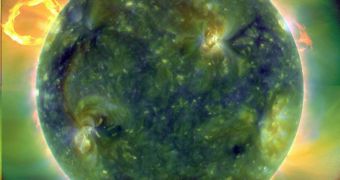NASA engineers announce that the newly-launched Solar Dynamics Observatory (SDO) has just sent back early images of our Sun. The data confirms the amazing capabilities that the designers of the telescope advertised before sending it to space. The observatory was created to look at the star in the extreme ultraviolet (EUV) portion of the electromagnetic spectrum, and to reveal even minute traces of activity in the Sun at these wavelengths. Gaining a better understanding of how the star functions is of significant implications for various fields of research, as the Sun influences our planet considerably.
“These initial images show a dynamic Sun that I had never seen in more than 40 years of solar research. SDO will change our understanding of the Sun and its processes, which affect our lives and society. This mission will have a huge impact on science, similar to the impact of the Hubble Space Telescope on modern astrophysics,” explains the director of the NASA Heliophysics Division, Richard Fisher, who is based at the space agency's Headquarters, in Washington, DC. The new measurement SDO sent back provide the first high-resolution data on solar flares, using a broad range of EUV wavelengths, experts at NASA report on their official website.
“I’m so proud of our brilliant work force at Goddard, which is rewriting science textbooks once again. This time Goddard is shedding new light on our closest star, the Sun, discovering new information about powerful solar flares that affect us here on Earth by damaging communication satellites and temporarily knocking out power grids. Better data means more accurate solar storm warnings,” adds the chairwoman of the US Commerce, Justice and Science Appropriations Subcommittee, Senator Barbara Mikulski, D-Md. The Subcommittee is in charge of funding NASA.
The new observatory was built at the NASA Goddard Space Flight Center (GSFC), in Greenbelt, Maryland, for the NASA Science Mission Directorate, in Washington. The Center also operates and manages the telescope, which was launched on February 11, 2010. According to its specifications, the SDO is the most technologically-advanced spacecraft to be dedicated to studying the Sun. It “will determine how the sun's magnetic field is generated, structured and converted into violent solar events such as turbulent solar wind, solar flares and coronal mass ejections. These immense clouds of material, when directed toward Earth, can cause large magnetic storms in our planet’s magnetosphere and upper atmosphere,” NASA experts add.

 14 DAY TRIAL //
14 DAY TRIAL //